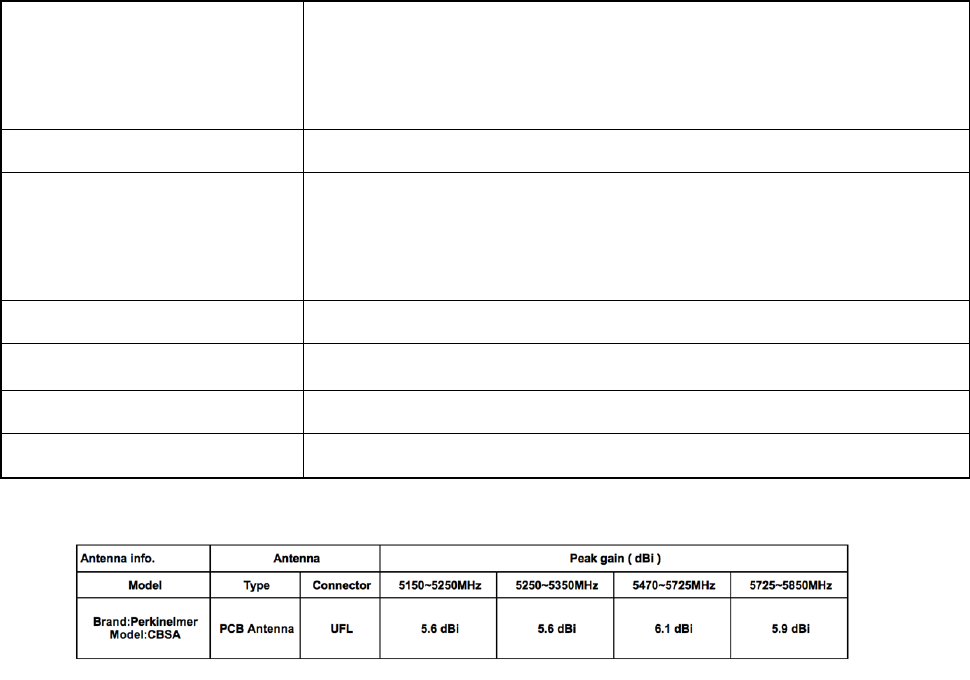Varex Imaging Deutschland XRPAD2 802.11n 3T3R Mini PCIe Module User Manual WPEA 127NI FCC manual1030x
PerkinElmer Medical Imaging 802.11n 3T3R Mini PCIe Module WPEA 127NI FCC manual1030x
Contents
- 1. User manual
- 2. Users Manual
User manual

Standard
IEEE802.11 an
Chipset
Atheros AR9390-AL1B
Radio stream [Note1]
3T3R
Antenna Type / con.
3 U.FL connectors (diversity ant)
Bus Interface
PCI Express
Form Factor
Mini PCIe
Data Rate
802.11a: 54, 48, 36, 24, 18, 12, 9, 6 Mbps
802.11n: MCS 0 to 23 for HT20MHz
MCS 0 to 23 for HT40MHz
Media Access Control
CSMA/CA with ACK
Spreading /Modulation
Techniques
802.11a: OFDM (BPSK, QPSK, 16-QAM, 64-QAM)
802.11n: OFDM (BPSK,QPSK,16-QAM,64-QAM)
Frequency Range [Note2]
5GHz
11a/n: 5.150GHz ~ 5.825GHz
Transmit Output Power
(Tolerance: +/-2dBm)
802.11a: 11dBm ± 2dBm@54Mbps
802.11an HT20: 15dBm ± 2dBm@MCS0
802.11an HT20: 11dBm ± 2dBm@MCS7
802.11an HT40: 15dBm ± 2dBm@MCS0
802.11an HT40: 11dBm ± 2dBm@MCS7
Receiver Sensitivity
(Tolerance: +/-2dBm)
802.11a: -78dBm ± 2dBm@54Mbps
802.11an HT20: -95dBm ± 2dBm@MCS0

802.11an HT20: -75dBm ± 2dBm@MCS7
802.11an HT40: -93dBm ± 2dBm@MCS0
802.11an HT40: -72dBm ± 2dBm@MCS7
Operating Voltage
3.3V ±10% I/O supply voltage
Power Consumption
TX Mode: 970mA
RX Mode: 300mA
Associated Idle: 50 mA
Temperature Range
-40~+80°C (Operating) [Note3]
Humidity (non-condensing)
20~80%(Operating), 5~95%(Storing) [Note3]
Security
WEP / WPA / WPA2
OS supported
Windows XP/Vista/Win7, Linux
Federal Communication Commission Interference Statement
This equipment has been tested and found to comply with the limits for a Class B
digital device, pursuant to Part 15 of the FCC Rules. These limits are designed to
provide reasonable protection against harmful interference in a residential installation.
This equipment generates, uses and can radiate radio frequency energy and, if not
installed and used in accordance with the instructions, may cause harmful interference
to radio communications. However, there is no guarantee that interference will not
occur in a particular installation. If this equipment does cause harmful interference to
radio or television reception, which can be determined by turning the equipment off
and on, the user is encouraged to try to correct the interference by one of the following
measures:
- Reorient or relocate the receiving antenna.
- Increase the separation between the equipment and receiver.
- Connect the equipment into an outlet on a circuit different from that
to which the receiver is connected.
- Consult the dealer or an experienced radio/TV technician for help.
FCC Caution: Any changes or modifications not expressly approved by the party
responsible for compliance could void the user's authority to operate this equipment.
This device complies with Part 15 of the FCC Rules. Operation is subject to the
following two conditions: (1) This device may not cause harmful interference, and (2)
this device must accept any interference received, including interference that may
cause undesired operation.
IMPORTANT NOTE:
Radiation Exposure Statement:
The product comply with the US portable RF exposure limit set forth for an
uncontrolled environment and are safe for intended operation as described in this
manual. The further RF exposure reduction can be achieved if the product can be kept
as far as possible from the user body or set the device to lower output power if such
function is available.
This transmitter must not be co-located or operating in conjunction with any other
antenna or transmitter.
Country Code selection feature to be disabled for products marketed to the
US/CANADA

This device is intended only for OEM integrators under the following conditions:
1) The transmitter module may not be co-located with any other transmitter or
antenna,
As long as the condition above is met, further transmitter test will not be required.
However, the OEM integrator is still responsible for testing their end-product for any
additional compliance requirements required with this module installed
IMPORTANT NOTE
In the event that these conditions can not be met (for example certain laptop
configurations or co-location with another transmitter), then the FCC authorization is
no longer considered valid and the FCC ID can not be used on the final product. In
these circumstances, the OEM integrator will be responsible for re-evaluating the end
product (including the transmitter) and obtaining a separate FCC authorization.
End Product Labeling
The final end product must be labeled in a visible area with the following: “Contains
FCC ID: 2AA8Z-XRPAD2”.
Manual Information to the End User
The OEM integrator has to be aware not to provide information to the end user
regarding how to install or remove this RF module in the user’s manual of the end
product which integrates this module.
The end user manual shall include all required regulatory information/warning as show
in this manual.